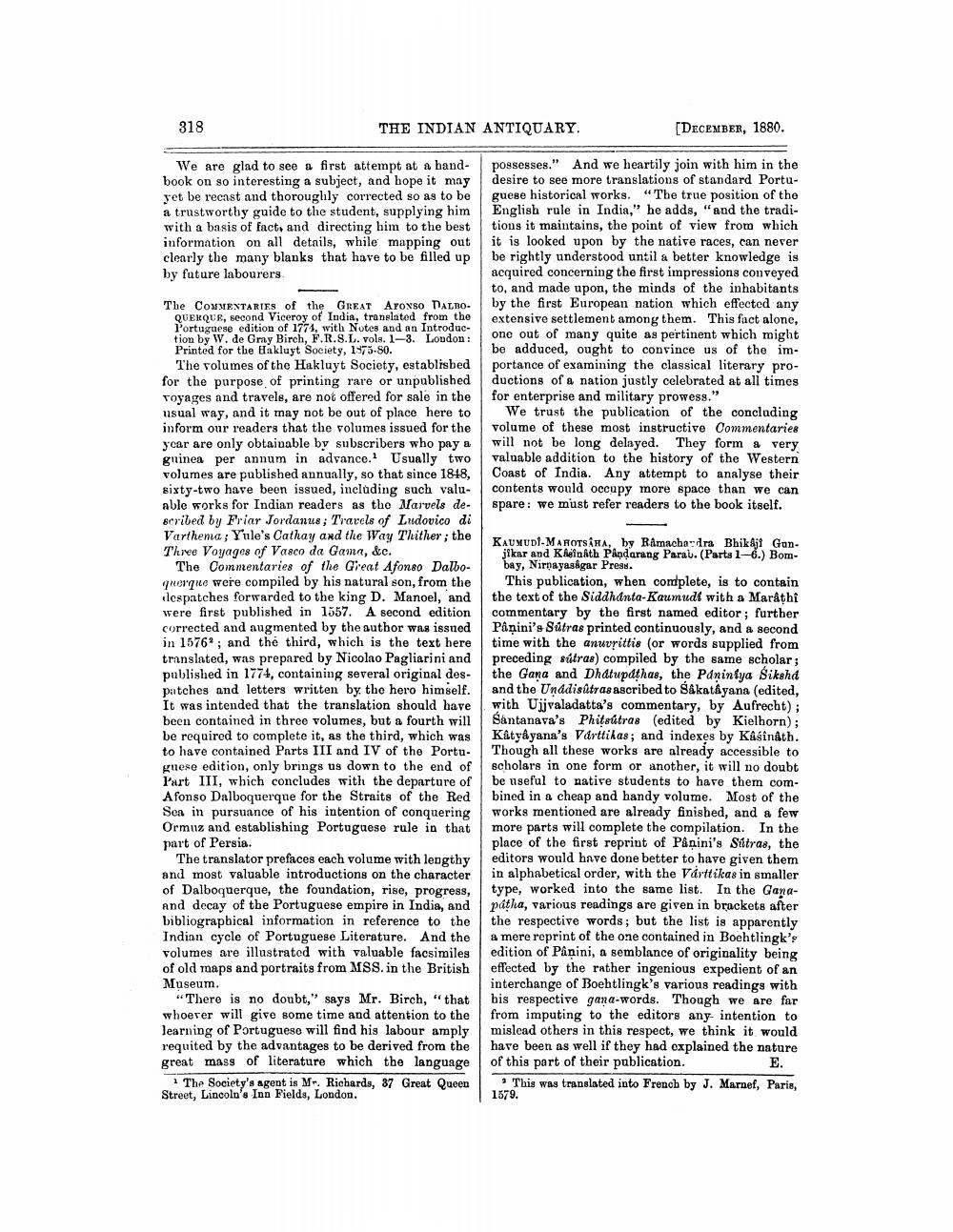________________
318
THE INDIAN ANTIQUARY
[DECEMBER, 1880.
We are glad to see a first attempt at a bandbook on so interesting a subject, and hope it may yet be recast and thoroughly corrected so as to be a trustworthy guide to the student, supplying him with a basis of fact, and directing him to the best information on all details, while mapping out clearly the many blanks that have to be filled up by future labourers
possesses." And we heartily join with him in the desire to see more translations of standard Portuguese historical works. “The true position of the English rule in India," he adds, "and the traditions it maintains, the point of view from which it is looked upon by the native races, can never be rightly understood until a better knowledge is acquired concerning the first impressions conveyed to, and made upon, the minds of the inhabitants by the first European nation which effected any extensive settlement among them. This fact alone, one out of many quite as pertinent which might be adduced, ought to convince us of the importance of examining the classical literary productions of a nation justly celebrated at all times for enterprise and military prowess."
We trust the publication of the concluding volume of these most instructive Commentaries will not be long delayed. They form a very valuable addition to the history of the Western Coast of India. Any attempt to analyse their contents would occupy more space than we can spare: we must refer readers to the book itself.
The COMMENTARIES of the GREAT AroxsO TALDO
QUERQUE, second Viceroy of India, translated from the Portuguese edition of 1774, with Notes and an Introduction by W. de Gray Birch, F.R.S.L. vols. 1-3. London: Printed for the Hakluyt Society, 1975-80.
The volumes of the Hakluyt Society, establisbed for the purpose of printing rare or unpublished voyages and travele, are not offered for sale in the usual way, and it may not be out of place here to inform our readers that the volumes issued for the year are only obtainable by subscribers who pay a guinea per annum in advance. Usually two volumes are published annually, so that since 1848, sixty-two have been issued, including such valuable works for Indian readers as the Marvels de scribed by Friar Jordanus; Travels of Ludovico di Varthenia; Yule's Cathay and the Way Thither; the Three Voyages of Vasco da Gama, &c.
The Commentaries of the Great Afonso Dalboquerque were compiled by his natural son, from the
lespatches forwarded to the king D. Manoel, and were first published in 1557. A second edition corrected and augmented by the author was issued in 1576; and the third, which is the text here translated, was prepared by Nicolao Pagliarini and published in 1774, containing several original despatches and letters written by the hero himself. It was intended that the translation should have been contained in three volumes, but a fourth will be required to complete it, as the third, which was to have contained Parts III and IV of the Portuguese edition, only brings us down to the end of l'art III, which concludes with the departure of Afonso Dalboquerque for the Straits of the Red Sen in pursuance of his intention of conquering Ormuz and establishing Portuguese rule in that part of Persia.
The translator prefaces each volume with lengthy and most valuable introductions on the character of Dalboquerque, the foundation, rise, progress, and decay of the Portuguese empire in India, and bibliographical information in reference to the Indian cycle of Portuguese Literature. And the volumes are illustrated with valuable facsimiles of old maps and portraits from MSS. in the British Museum.
"There is no doubt," says Mr. Birch, "that whoever will give some time and attention to the learning of Portuguese will find his labour amply requited by the advantages to be derived from the great mass of literature which the language
i The Society's agent is Mr. Richards, 37 Great Queen Street, Lincoln's Inn Fields, London.
KAUMUDI-MAROTS ARA, by Ramachardra Bhikaji Gan
jikar and K Minath Pandarang Parau. (Parts 1-6.) Bombay, Nirnayasagar Press.
This publication, when complete, is to contain the text of the Siddhanta-Kaumudi with a Marathi commentary by the first named editor; further Pånini's Sátras printed continuously, and a second time with the anuvrittis (or words supplied from preceding sátras) compiled by the same scholar; the Gana and Dhatupathas, the Paninfya Siksha and the Unddisutras ascribed to Såkat yana (edited, with Ujjvaladatta's commentary, by Aufrecht); Santanava's Phitsútras (edited by Kielhorn); Katyayana's Varttikas; and indexes by Kasináth. Though all these works are already accessible to scholars in one form or another, it will no doubt be useful to native students to have them combined in a cheap and handy volume. Most of the works mentioned are already finished, and a few more parts will complete the compilation. In the place of the first reprint of Pånini's Sitras, the editors would have done better to have given them in alphabetical order, with the Varttikas in smaller type, worked into the same list. In the Ganapatha, various readings are given in brackets after the respective words; but the list is apparently a mere reprint of the one contained in Boehtlingk's edition of Panini, a semblance of originality being effected by the rather ingenious expedient of an interchange of Boehtlingk's various readings with his respective gana-words. Though we are far from imputing to the editors any intention to mislead others in this respect, we think it would have been as well if they had explained the nature of this part of their publication.
This was translated into French by J. Marnef, Paris, 1579.




